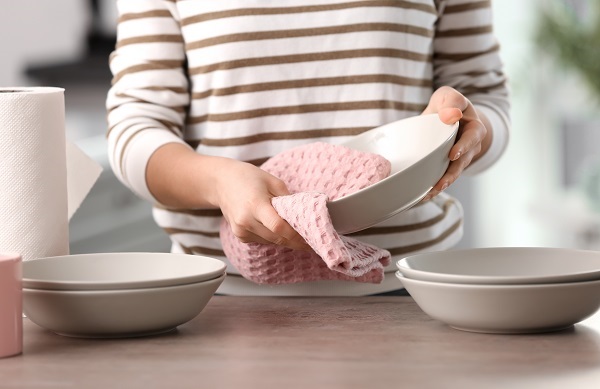Modern dishwashers have numerous washing and drying options to maximize performance. So why does my Samsung dishwasher not dry the dishes as well as expected? The water temperature may be too cool for optimum drying. Determine why your Samsung dishwasher leaves dishes wet with these common causes and solutions.
Samsung Dishwasher Leaves Dishes Wet?
Try These Troubleshooting Tips.
In most cases, a simple adjustment to your dishwasher use and care can improve drying performance. Whether it’s changing your loading practices or your wash settings, these Samsung dishwasher troubleshooting tips can result in dryer dishes.
1. Dishwasher is Overcrowded
Overcrowding with too many items is one of the most common reasons a Samsung dishwasher leaves dishes wet. When dishes or silverware nest or overlap each other there’s little room for hot air to circulate, leaving items wet.
Use these rack-by-rack dishwasher loading tips to avoid overcrowding and promote drying:
- Top rack: Reserve for bowls, glasses, mugs and small plates. Place concave items upside down, at an angle, to improve rinsing and enhance drying.
- Bottom rack: Designed for dinner plates, serving platters and cookware. Place one dish per slot to ensure adequate space for air flow.
- Silverware basket: Alternate forks, spoons and knives next to each other to prevent nesting.

2. Unloading Out of Order
How you unload the dishwasher can be just as crucial to dryer dishes as proper loading. If you unload the top rack first, any residual water will fall on the bottom rack below. When this happens, it can seem like your Samsung dishwasher doesn’t dry dishes because bottom rack items are wet again. Always unload the bottom rack first so any lingering water from above falls on an empty rack.
3. Insufficient Water Temperature
Hot water evaporates faster than cold water, resulting in dryer dishes. A water temperature of 120-149℉ is recommended to enhance your dishwasher’s cleaning and drying capabilities.
If your Samsung dishwasher leaves dishes wet, make sure it’s properly connected to your home’s hot water source. If the water temperature in your kitchen sink measures less than 120℉, raise the temperature on your home’s hot water heater. If cooler water temperatures persist, a plumber may need to assess for potential water heating issues.
4. Use Dry Cycle Options
If you find your Samsung dishwasher not drying dishes to your liking, try utilizing the enhanced drying options that some models offer.
The following cycle options can lead to dryer dishes:
- Dry+: The final rinse cycle uses hotter water for faster evaporation. Drying time is also increased.
- Heated Dry: The dishwasher uses a heater to warm the air inside the dishwasher, enhancing the standard condensation drying process.
- Hi-Temp Wash: Uses a hotter water temperature that removes caked-on stains and results in faster evaporation during drying.

5. Add Samsung Dishwasher Rinse Aid
Rinse aid is an essential component to the condensation drying process utilized by most Samsung dishwashers. Rinse aid facilitates drying by altering the structure of water droplets. This enables them to drip and evaporate off of dishes and glassware with greater ease.
Always add rinse aid to your dishwasher’s designated dispenser with each wash load. If you still find that your Samsung dishwasher leaves dishes wet, adjust the dial on the dispenser to a higher setting. This accommodates more rinse aid to assist in drying larger loads.
If these DIY tips don’t improve your dishwasher’s drying performance, it may be time to consult a professional dishwasher repair service. From insufficient drying to a dishwasher not starting, the experts at CD Appliance Repair can solve the problem!






